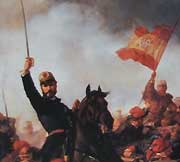Industrialisation and the First Republic
1868 - 1898
 Queen
Isabel wasn't able to stop the liberal wave and in 1868 La Gloria
Revolution made her flee for France. Queen
Isabel wasn't able to stop the liberal wave and in 1868 La Gloria
Revolution made her flee for France.
After two yearts of political turmoil, the parties came to an agreement
that a new constitutional monarch was needed. Valencia was instrumental
in making this arrangement. In 1871 Amadeo I was elected as the new King
of Spain in Sagunto, close to Valencia, with a strong backing of the Valencian
elite. Amadeo, however, failed to find the right balance between liberalism
and control, and finally abdicated in 1873. The First Republic took his
place, with a provisional borgeois government in charge, who set on looking
for a new consitutional monarch.
The liberalist tendencies were radicalising all over Spain and a Canton
sub-revolution was taking part - Spanish cities were declaring themselves
autnomous as part of the Spanish federation. The provisional republican
government used force to keep Spain from breaking up. Valencia too declared
itself a Canton of Valencia, although it was never as radical as others.
However, in 1873, after the abdication of Amadeo, the government troops
bombarded the city all the same, forcing it to abandon the Cantons.
In 1874 the very same general who was so effective against the Cantons,
Martinez Campos, turned on the Repiblic itslef.
The Bourbon dynasty was restored in 1875 with Alfonso XII, commencing
the period of Restoration. Until the first quarter of XX century it was
a period of political stability, liberal monarchy communicaing effectively
with parties and social movements.
 In
the second half of XIX century Valencia recovered its economy crippled
by the collapse of the silk trade. Steam manufacture rapidly industrialised
Valencia. Scores of impoverished artesans took their place at the factory
machines. Valencia's population quadrupled over the course of the century
and the city walls were taken down in 1865 to facilitate expansion of
the city. New residential districts of L'Example (where Canovas
presently is) sprung up, creating a property market - an important part
of economy. In
the second half of XIX century Valencia recovered its economy crippled
by the collapse of the silk trade. Steam manufacture rapidly industrialised
Valencia. Scores of impoverished artesans took their place at the factory
machines. Valencia's population quadrupled over the course of the century
and the city walls were taken down in 1865 to facilitate expansion of
the city. New residential districts of L'Example (where Canovas
presently is) sprung up, creating a property market - an important part
of economy.
By the end of the century Valencia was booming. The industry was outputing
metals, tiles, chemicals and furniture. New roads, a railway and a modernised
port facilitated distribution of goods. A large layer of well-doing bourgeois
rotated their investements in trade, banking and orange plantations. A
group of big businessmen energetically took the city infrastructures upon
themeslves - transport, electricity, sewer system, water supplies - making
a big impact on the progress of economy.
More and more of the rural emigrants streamed to Valencia to take their
place at the factories, in the process organising themselves to confront
the employers. By the end of the XIX century they were either socialist
or anarchist, although the conflict with the bourgeois was generally non-violent.
|